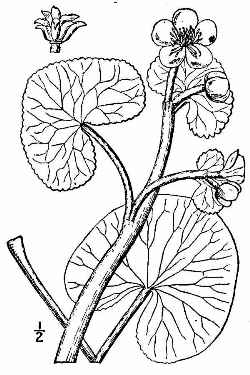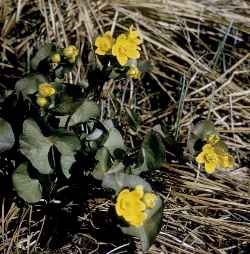
Britton, N.L., and A. Brown. 1913. Illustrated flora of the northern states and Canada. Vol. 3: 20. Courtesy of Kentucky Native Plant Society. Scanned by Omnitek Inc.
Sunset®: All zones
USDA: 3-9
Sun Exposure: Sun to light shade
Origin: Circumboreal Northern America (south to North Carolina, Tennessee, Iowa, Nebraska, and Oregon), Eurasia
Growth Habits: Perennial, 12 to 18 inches tall and wide (30-45 cm) rounded, heart, or kidney-shaped leaves 3 to 7 inches wide (7-17 cm)
Flowers: Yellow flowers
Watering Needs: Bog or marsh plant, needs a lot of water
Propagation: Division in early spring or summer, seeds

Robert H. Mohlenbrock @ USDA-NRCS PLANTS Database / USDA NRCS. 1995. Northeast wetland flora: Field office guide to plant species. Northeast National Technical Center, Chester, PA.
The entire plant is poisonous.
Several cultivars are found in specialized nurseries:
- 'Alba', has white flowers
- 'Plena', has large double flowers and should be propagated vegetatively since it generally doesn't come true when sowed.
Blooming Habits:
Cup-shaped, waxy yellow flowers, in clusters of 1 to 7, 1 to 2 inches wide (2.5-5 cm), in early spring. They come on long stalks above the foliage.
Culture:
The Caltha dies to the ground by midsummer.
Desert-Tropicals is dedicated to provide gardening advice, gardening ideas, and information about flower of all kind for landscape and collections.We try to check carefully the identification of the plants on the illustrations as well as the other information from the page, but occasionally errors do occur. if you notice anything that needs to be changed please contact us.Thanks.
© 1998-2020 Philippe Faucon, All Rights Reserved.